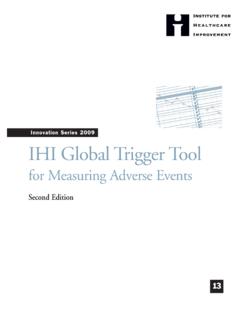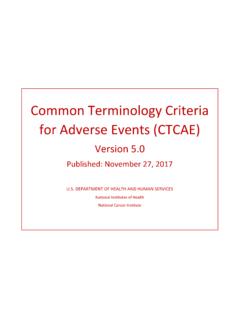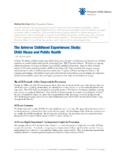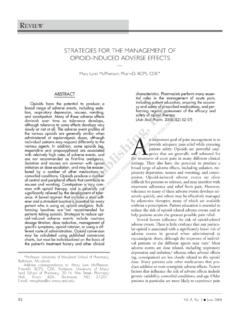Transcription of ADDRESSING ADVERSE CHILDHOOD EXPERIENCES TO …
1 1 ADDRESSING ADVERSE CHILDHOOD EXPERIENCES TO IMPROVE PUBLIC HEALTH: EXPERT CONSULTATION, 4-5 MAY 2009 MEETING REPORT 2 Background In the decade since the first ADVERSE CHILDHOOD EXPERIENCES (ACE) Study results were published, a number of other initiatives in developed and developing countries, have begun examining the consequences of child maltreatment and other traumatic stressors for health risk behaviours and long-term chronic disease consequences. These include a comparative risk assessment of child sexual abuse to inform the global burden of disease (GBD) estimates; the Global Schools-based Student Health Survey (GSHS), the International Society for Prevention of Child Abuse and Neglect (ISPCAN) International Child Abuse Screening Tool (ICAST), and country-specific projects ( in Australia, China, Malaysia, Singapore, South Africa, Swaziland, Vietnam). These developments have occurred in a context of raised global awareness of the consequences of child maltreatment following the launch of reports such as the World report on violence and health and the UN Study on Violence against Children, in which the ACE Study and other findings about CHILDHOOD adversity play a prominent role in highlighting the long-term consequences of child maltreatment.
2 Most recently, both CDC's Violence Prevention Division and WHOs Department of Violence and Injury Prevention and Disability have prioritized child maltreatment prevention, and there is widespread interest at country level in conducting surveys to examine the prevalence and consequences of child maltreatment and commence the development of policies and programmes designed to prevent child maltreatment and mitigate its acute and long-term consequences. However, while some high-income countries have awoken to the major public health implications attaching to ACEs by stepping up their primary prevention efforts, most of the world's children are in low- and middle-income countries, where, although the prevalence of CHILDHOOD adversities is sometimes higher than in wealthy countries, governments have yet to act on the recognition that CHILDHOOD adversities underlie serious, long-lasting consequences which: compromise individual health and development including the ability to learn in school; generate costly health problems such alcohol and drug abuse, mental illness, interpersonal violence, sexual assault, smoking, STDs, and transmission of HIV undermine community and neighbourhood support structures; create a climate in which crime can flourish; inhibit economic development, and erode safety and security.
3 Accordingly, and as part of wider violence and injury prevention, chronic disease prevention, and health promotion cooperative agreements between CDC and WHO, the two agencies agreed to strengthen their work on understanding and documenting ACEs and to jointly work towards establishing relationships with country counterparts to build a global network focused on: understanding the long-term health risk behaviour and chronic disease consequences of child maltreatment and traumatic stress; 3 Promote future cross-country and cross-study comparisons of the risk behaviour, chronic disease consequences, and burden of child maltreatment, ultimately leading to a more robust evidence base from which to develop prevention programmes; and Create opportunities for CDC and WHO to provide technical assistance and programmatic advice to global partners in this focus area. Meeting Agenda To create a framework within which CDC, WHO and its partners can collaborate to achieve the above project objectives, the meeting agenda for the expert consultation addressed the following topics.
4 A brief overview of the most prominent international initiatives aimed at documenting the relationships between CHILDHOOD adversities, health risk behaviours and chronic disease consequences ( , ACE; GSHS; ISPCAN- ICAST; GBD); An opportunity for participants to showcase and share their plans and ongoing work in the study of child maltreatment and traumatic stress; Discussion of the potential benefit of developing a basic set of common methods and data collection processes, including the possibility of establishing core and optional questions that would allow for future cross-country and cross-study comparisons, and meta-analyses; Discussion of the need to integrate existing knowledge on child maltreatment and traumatic stressors and their long-term chronic disease consequences into a broader public health and social development framework and strategies for doing so; Discussion of the need for broad-based outcome measures and possible new areas ( , education, job performance; antisocial and criminal behaviour) for defining non-health outcomes of CHILDHOOD adversity and traumatic stress.
5 Meeting Participants Meeting participants included individuals working in the fields of public health and early child development from Canada, China, Former Yugoslav Republic of Macedonia, Philippines, Saudi Arabia, South Africa, Switzerland and Thailand. Apologies were received from Michael Dunne (Australia), and Laura Kann (US Centers for Disease Control and Prevention). Participants from WHO included technical staff from the departments of Violence and Injury Prevention and Disability; Chronic Disease Prevention and Health Promotion; Reproductive Health and Research; and Child and Adolescent Health. Annex 1 provides the full list of participants. 4 ADVERSE CHILDHOOD EXPERIENCES : Nature and Consequences "In the brain, as in the economy, getting it right the first time is ultimately more effective and less costly than trying to fix it later". James Heckman; Nobel Laureate Economist. National Scientific Council on the Developing Child, Perspectives: The Cradle of Prosperity. (2006).
6 Presentations on the nature and consequences of ACEs highlighted their defining characteristics as being biological stressors that disrupt human neurological development and, in turn, interfere with normal cognition and behaviour. Individual ACEs have a cumulative effect which can be expressed as the sum of all ACEs an individual is exposed to, or "trauma dose". ACE studies show that the higher the ACE score (and therefore the trauma dose), the more frequent and severe the consequences in respect of cognitive and behavioural disturbances (known as a "dose-response relationship"). Referring to findings from the original ACE study of approximately 17,000 middle-class Californians, it was shown that ACEs are highly prevalent ( 28% of respondents had experienced physical abuse, 21% sexual abuse, and 13% had witnessed their mother being beaten), and have a strong influence on adolescent health; reproductive health; smoking; alcohol abuse; illicit drug abuse; sexual behaviour; mental health; the risk of violence and re-victimization; stability of relationships, homelessness; and performance in the workforce.
7 Via these behaviours and other neuro-biological pathways, ACEs increase the risk of: heart disease; chronic lung disease; liver disease; suicide; injuries, HIV and STDs, and other risks for the leading causes of death. While compelling, findings from the original ACE study are specific to middle-class US citizens, begging the question as to whether the same dose-response relationships exist in other settings. The GSHS includes a module that has questions on a number of adversities experienced in the past year, which to date has been included in nearly 50 country surveys. Findings for a pooled sample of 22,256 respondents from five African countries demonstrate significant dose-response relationships between adversities such as forced sex and bullying, and risk behaviours such as smoking, alcohol abuse, unsafe sex, and attempted suicide1. Findings from community-based surveys in mainland China, Hong Kong SAR, Taiwan, Singapore and Malaysia also show that adolescents in these cultures experience a substantial health burden from exposure to various adversities2.
8 Although not designed to replicate the original ACE survey's exploration of adversity in infancy and early CHILDHOOD , these other findings strongly suggest the universality of ACE effects and consequences. 1 Brown DW et al. Exposure to physical and sexual violence and ADVERSE health behaviours in African children: results from the Global School-based Student Health Survey. Bull World Health Organ 2009;87: 447 455. 2 Dunne MP et al. (2008). The evolving evidence base for child protection in Chinese societies. Asia-Pacific Journal of Public Health, 20(4), 267-276. 5 Viewed through a public health lens, ACEs are widely prevalent; highly interrelated; and intergenerational. They have a cumulative stressor (dose-response) effect; their effects are biologically plausible; they affect multiple domains of health and social function, and they are associated with comorbidity (trauma spectrum disorder). As such, many conditions that public health seeks to prevent as if they were the primary problems - such as smoking, alcohol and substance misuse, depression, STDs, and so on - are seen to be the diverse outcomes, or symptoms, of a common set of underlying determinants.
9 Consequently, ACEs themselves are the primary problem, and for a truly preventive, upstream approach, public health and social development policies and programmes need to be explicitly aimed at ACE reduction. Methodological Issues The original ACE study, and other population-based surveys ( GSHS, the WHO Multi-country Study on Violence Against Women) exploring relationships between various exposures, risk behaviours and health conditions use cross-sectional retrospective study designs. Within the ACE study itself, the reporting of adversities is retrospective; ascertainment of health and social problems was cross-sectional at baseline, and the study has a prospective component involving the ascertainment of outcomes such as disease, health care utilization, pharmacy utilization, and mortality. While criticized on the grounds that they are of limited value in establishing causal relationships, and that recall bias may lead to the under- or over-inclusion of events, retrospective cross-sectional designs do provide a well-tested and widely-used approach to examining the experience of populations over time to estimate the association between exposure and outcome.
10 The alternative is to use a prospective longitudinal study design, which registers exposures as they occur and uses objective risk and outcome measures. However, prospective longitudinal designs have their own weaknesses. For instance, the ethical imperative of intervening where currently occurring child maltreatment is disclosed during a prospective longitudinal study means that such studies cannot examine the effects of unmitigated exposure; they are costly and complex to mount, and may be unfeasible in low- and middle-income countries with high residential mobility. The ideal methodology for measuring ACEs and their effects has yet to be designed. Retrospective cross-sectional and prospective longitudinal studies both have strengths and weaknesses - both have been applied in different settings, and both provide evidence that CHILDHOOD adversity is an important health and social problem. The validity of various methods for of assessing and studying maltreatment and other adversities is a source of ongoing debate, and efforts to advance the field should draw upon the strengths of prospective and retrospective 1 Gilbert R.















